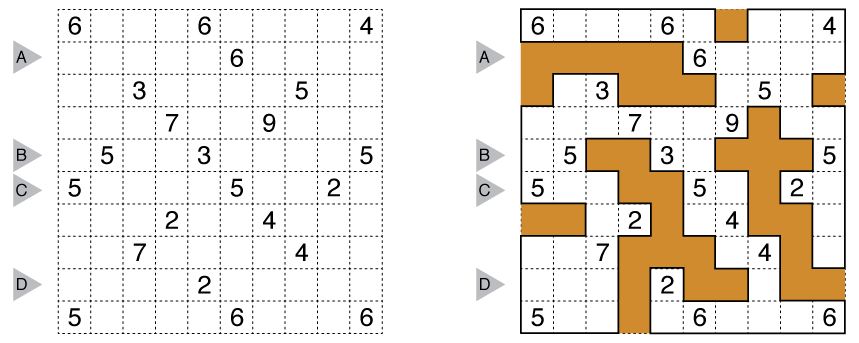Cave Rules and Info

Rules: Shade some cells to leave behind a single connected group — the cave — with no enclosed, shaded cells. In other words, all shaded cells must be connected by other shaded cells to an edge of the grid. All numbered cells must be a part of the cave, with each number indicating the total count of cells connected vertically and horizontally to the numbered cell including the cell itself.
Answer String: Enter the length in cells of each of the cave segments from left to right for the marked rows, starting at the top. Separate each row’s entry with a comma. This example has the key “5,221,322,311”.
(Brief) History of Cave: This style was first published under the name “BAG” in 1996 by Nikoli; the original author was ゲサクですよ (Gesaku Desu Yo – “It’s Comedy!”). It borrows many rules from another Nikoli style, Kuromasu (Where Is Black Cells?), which first appeared in 1991. The original presentation of BAG involved drawing a single non-intersecting loop, and this style persisted when the puzzle first came to the West under the new name “Corral” for the 2002 US/Canadian Qualifying Test for the World Puzzle Championship. A different presentation and set of rules has evolved over time involving shading cells instead of forming a loop; this presentation has gone by the name “Cave” at the World Puzzle Championship, and is the format and name used here at Grandmaster Puzzles.
History of this example: This Cave was written by Thomas Snyder for his “Better Know the USPC series” with solving tips that are highly recommended for the style.
Sources for Cave Puzzles: Follow this link for classic Cave puzzles on this website and this link for variations on Cave puzzles. If you are new to this puzzle type, here are our easiest Cave Puzzles to get started on. More Cave puzzles can be found in Roger Barkan’s Colossal Cave Collection, in The Art of Puzzles, and in our beginner-friendly collection Intro to GMPuzzles by Serkan Yürekli.
Design rules for contributors: A Grandmaster Cave will have a unique solution that can be reached by logic alone. Generally, a Grandmaster Cave should have symmetry or a theme that is interesting enough to not require symmetry.
